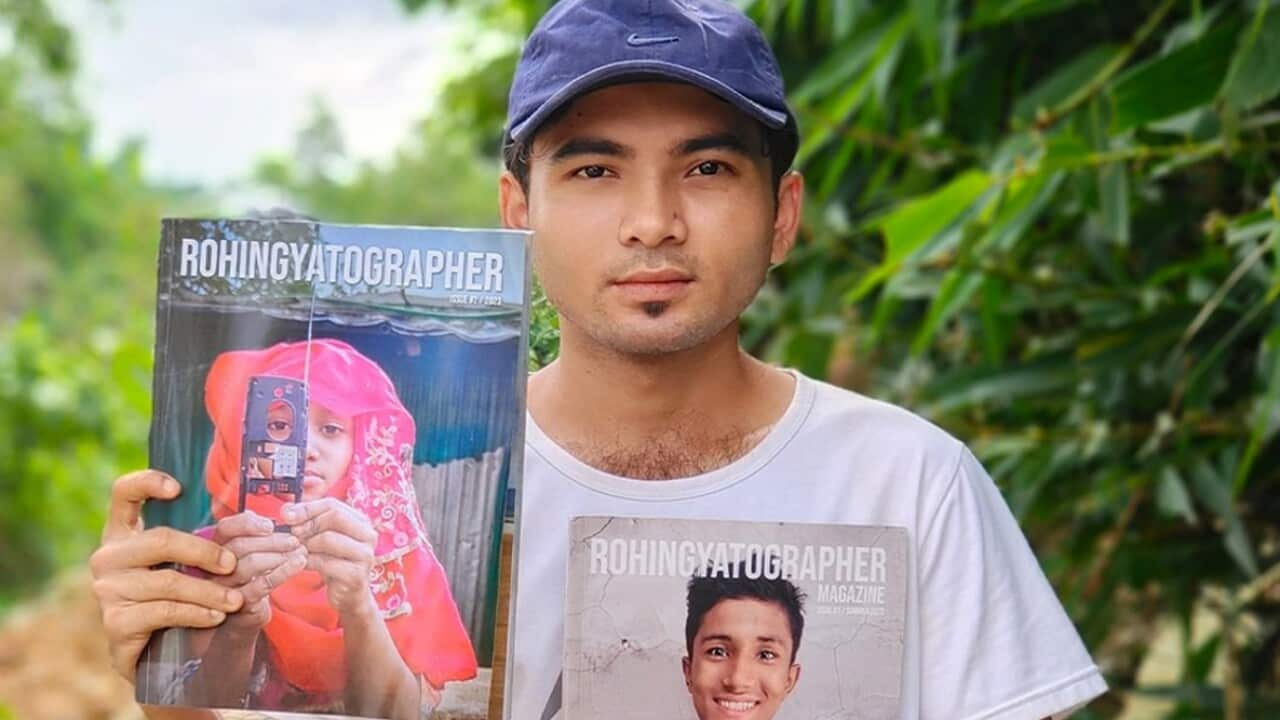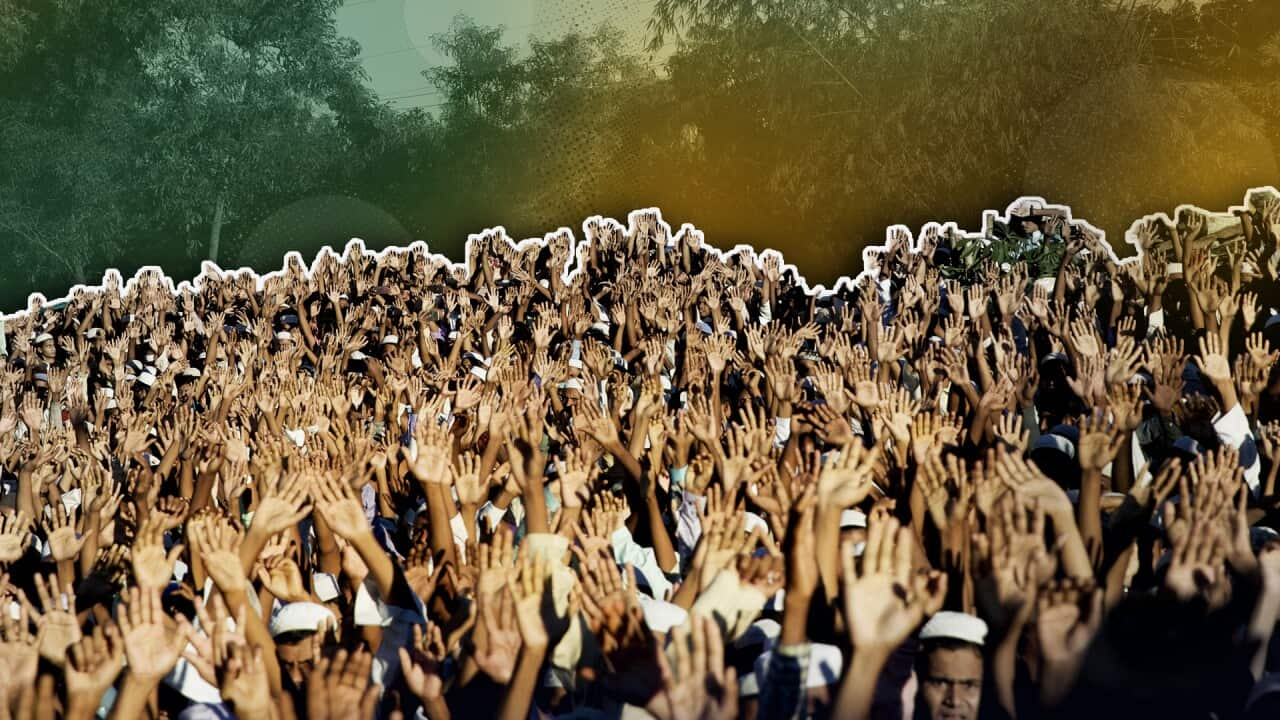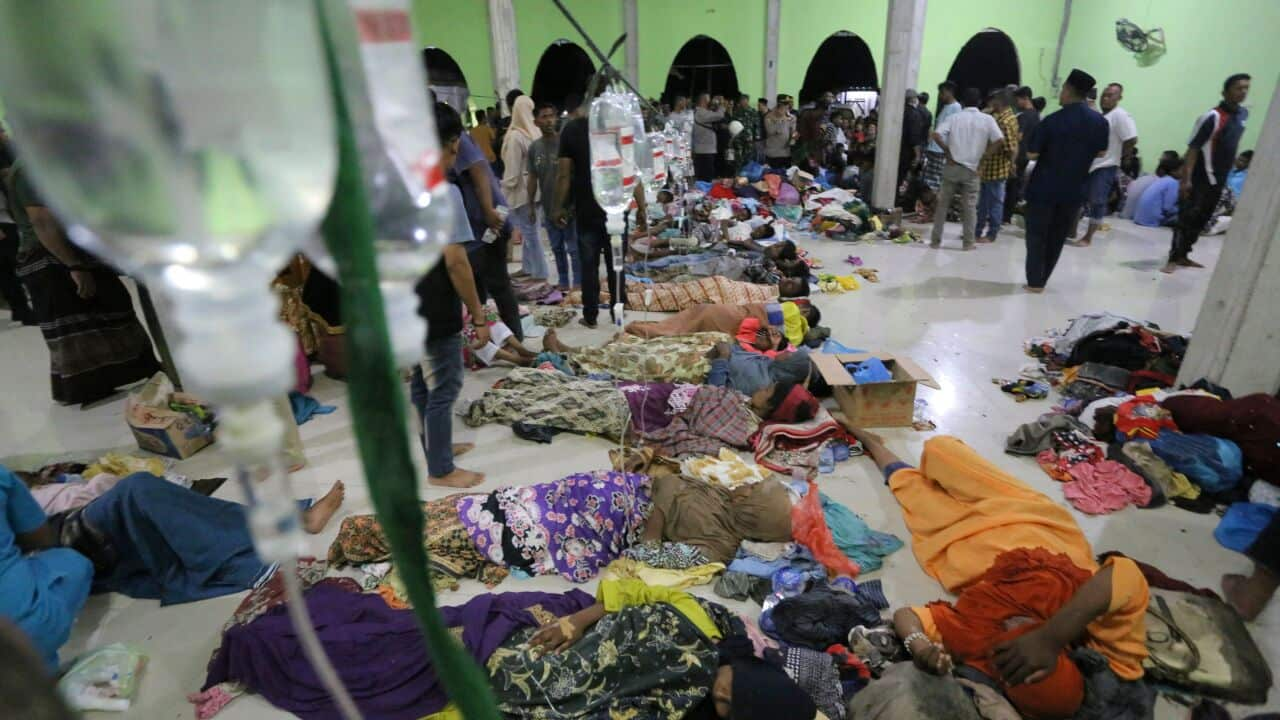It’s midnight, and Sahat Zia Hero can finally get down to work.
The 29-year-old is managing a photography magazine from the world’s largest refugee camp in southeastern Bangladesh, where he has been living for nearly six years. And it’s only at night when the internet connection in his shelter is stable, and he can access Google Drive and upload photographs he took during the day on his Vivo X60 Pro mobile phone.
“The only place where I get a good connection is a tea shop near my home. So I have to work on my magazine at night,” he told SBS Dateline.
Rohingyatographer, founded by Sahat, features photographs taken by young Rohingya on budget smartphones. Physical copies of the magazine are sold through its website. The most recent issue featured 217 photos from 20 photographers in the camp. The photographers’ work has been exhibited in Bangladesh, Germany and Australia.
Sahat, a one-time physics student, also runs photography workshops, even though he has mostly been learning via the internet.
The workshops and the magazine have been supported by UN agencies for migration and refugees, respectively.
Photography is giving young people a creative outlet in the refugee camp, where education and work opportunities are extremely limited. But Sahat believes there is a greater purpose in documenting their experiences: he feels his people are being forgotten by the international community. As stateless refugees, they can’t leave the camp, so photography is a way to connect to the world and advocate for their cause.
“I want people around the world to see us as human beings, to prioritise Rohingya like other refugees, and not forget us,” Sahat said.
Balukhali refugee camp, where he lives, merges with Kutupalong and other surrounding camps, forming a giant settlement that houses about a million Rohingya refugees. Most of them arrived in 2017 fleeing a crackdown by the Myanmar military that the United Nations human rights commissioner called a genocide and "a textbook example of ethnic cleansing". But persecution and discrimination against this Muslim minority by the Burmese government had persisted for decades.
Prolonged displacement with no prospect for repatriation in sight, worsening living conditions in the camp and a decline in international aid, has led to a rise in gang violence. It has also caused a growing number of desperate refugees to embark on dangerous and often deadly boat journeys in the hope of reaching Malaysia or Indonesia. In 2022, the UN recorded a 360 per cent increase in the number of those attempting the sea crossing.
The Rohingya are often called the 'forgotten people'.
Becoming a photographer inside a refugee camp

Zaudha, 40, cries as she looks at what was left of her home destroyed by the fire that broke out in the refugee camp in March 2021. She was Sahat’s neighbour. His family's shelter was also burnt to ashes. Source: Supplied / Sahat Zia Hero
When he arrived in the refugee camp and started working for a Danish humanitarian organisation, his daily tasks included reporting from the field.
“I took photos of damaged roads and shelters, fires and floods, and then started sharing them on social media to raise awareness about the struggles that we’re facing here in the camp,” he said.
Soon, his photos attracted the attention of international media.
In March 2021, a massive fire broke out in the camp, killing 15 and leaving some 50,000 people homeless. Among the displaced was Sahat’s family. The fire destroyed their shelter and all of their belongings.
“I lost my laptop and pen drives. It was the second time I lost everything since I fled my home in Myanmar,” he recalled.
Sahat and other photographers documented the aftermath of the fire at a time when no foreign journalists had access to the camp.
Some of those images as well as others capturing the natural calamities that descended upon the camp residents recently, such as cyclones and floods, have been compiled into the second issue of the Rohingyatographer magazine dedicated to elements and the resilience of the Rohingya. The first issue focused on identity and featured ‘a collective portrait of Rohingya’.
“I created this platform for young photographers so that they can tell their story by themselves, so that they can show their work and can connect with the international audiences,” Sahat said.
“It’s also really difficult to run a project like this from a refugee camp,” he added, stressing how crucial the support of Spanish photographer David Palazón in the production of the magazine has been. Finding sponsors is increasingly hard as international aid organisations face funding shortages for even the most basic needs of the refugees.
Recently, the collective received a small grant from a Southeast Asian non-profit to produce a special edition by Rohingya women photographers. To pay for the upcoming third issue of the magazine, they have launched a crowdfunding campaign on GoFundMe. In light of recent cuts to food rations, the issue will celebrate the culinary traditions of the Rohingya.
Dwindling international aid for Rohingya refugees in Bangladesh

Laila’s husband has a disability, so her family is fully dependent on humanitarian aid. But as World Food Programme announced food rations cuts for Rohingya refugees, she is worried for their livelihood. “I don't know how we can survive,” she said. Source: Supplied / Sahat Zia Hero
Some, like Sahat, have been able to get casual jobs with international aid agencies that pay them stipends.
UNHCR, the UN refugee agency, has called on Bangladeshi authorities to allow Rohingya refugees to work to provide for themselves as international aid agencies report a drastic drop in donations.
UNHCR and its Bangladeshi partners have received a quarter of the budget they need for the Rohingya response plan this year, as donors have shifted their focus to Ukraine and other new crises.
“We are prioritising funding needs even stricter than before, focusing on the most vulnerable and addressing the most critical gaps,” the agency told SBS Dateline in a statement, warning that the distribution of food, cooking gas and household items "will no longer be possible as a result of a reduction in financial support from the international community".
Since March, the World Food Programme has cut its food rations for Rohingya refugees from US$12 ($17.70) to US$8 ($11.80) a month per person.
The uncertain future for Rohingya youth

Rohingya children swim in muddy floodwaters during the rainy season. Source: Supplied / Sahat Zia Hero
Human Rights Watch has said that repatriation of Rohingya to Myanmar, where the military seized power in a 2021 coup, is not safe.
“The situation is getting worse in the camp. It’s not safe here, and the violence is rising because of delayed repatriation, less food, few opportunities for work and education,” Sahat said.
He received a good education in Myanmar even though he couldn’t finish his degree. He had studied physics at Sittwe University in the capital of the Rakhine State until the Burmese authorities barred Rohingya students from attending the university in mid-2012.
But a generation of Rohingya youth growing up in the refugee camp have been unable to receive formal education in Bangladesh as part of the government’s policy aimed at preventing them from settling in the country permanently. Until recently, only basic and primary-level education was available, and only to young children.
This year, an education program under the Myanmar school curriculum is being expanded to children of all ages, according to UNHCR. There’s also some vocations training offered in trades such as electrician, plumber or bakery staff.
The idea is that these skills will help Rohingya youth integrate into society and build their lives when they return to their homeland. When this day will come, however, is unknown.
Watch the 2018 Dateline investigation into the brutal expulsion of Rohingya from their country in Australia or elsewhere.













